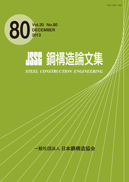All issues

Volume 20 (2013)
- Issue 80 Pages 80_1-
- Issue 79 Pages 79_1-
- Issue 78 Pages 78_1-
- Issue 77 Pages 77_1-
Volume 20, Issue 80
Displaying 1-7 of 7 articles from this issue
- |<
- <
- 1
- >
- >|
-
Norifumi YANAGISAWA, Ryosuke HASE, Osamu OHYAMA, Akimitsu KURITA2013 Volume 20 Issue 80 Pages 80_1-80_10
Published: December 25, 2013
Released on J-STAGE: December 20, 2014
JOURNAL FREE ACCESSIn order to protect a bridge against the fire attack mainly due to the turning over accident of a tank lorry vehicle, a Fire Protection Panel has been developed by the authors, because in a last decade it can see some serious damaged examples of viaduct and bridge by fire accident in USA, Germany, Japan and so on. Some of those bridges had fall down by fire attack and self-weight of bridge. The authors carried out the fire test and a numerical analysis of steel-concrete composite girder assembling Fire Protection Panel. This paper reports on the outline of the Fire Protection Panel and the experimental results of the temperature distributions in the steel girder compared with the analytical ones.View full abstractDownload PDF (2318K) -
Shizuo TSUJIOKA2013 Volume 20 Issue 80 Pages 80_11-80_17
Published: December 25, 2013
Released on J-STAGE: December 20, 2014
JOURNAL FREE ACCESSThis study is planed to clarify the seismic performance for existing steel structure using rolled-H section members. The cyclic loading tests with increasing amplitude were conducted on five welded beam-column subassemblages having a T-shape. The test parameters were the type of the column members and the beam-to-column connections. From the results of these tests, the hysteresis characteristics, the skeleton curve, the rotation rigidity, the yield strength and the ultimate strength are clarified. The vertical triangular haunch plates have great influence on the yield strength and the failure mode.View full abstractDownload PDF (2949K) -
Tsutomu HOSHIKAWA, Yukihiro HARADA2013 Volume 20 Issue 80 Pages 80_19-80_32
Published: December 25, 2013
Released on J-STAGE: December 20, 2014
JOURNAL FREE ACCESSThe purpose of the present study is to investigate how longitudinal stiffener plates can improve plastic deformation capacity of the H-section steel beams with a thinner web. Efficiency of the retrofit can be quantitatively estimated by an accumulated plastic deformation obtained from cyclic loading tests and numerical simulation. The quantitative estimate method of prevention effect of local buckling by the theory of elastic buckling of plates is proposed. The design procedure of stiffeners by prediction formula of plastic deformation capacity and increasing rate in strength is proposed.View full abstractDownload PDF (2170K) -
Yuji KOETAKA, Takashi HASEGAWA2013 Volume 20 Issue 80 Pages 80_33-80_45
Published: December 25, 2013
Released on J-STAGE: December 20, 2014
JOURNAL FREE ACCESSIn 2007, the building standard law of Japan was revised and a specification of column overdesign factor (COF) was added in case of square tube columns. These researches deal with existing non-conformed steel buildings using STKR columns according to being not satisfied with the specification of COF. In this paper, in order to enhance the full-plastic moment of column, reinforcement wrapping mortar around column base is proposed. An experimental verification of reinforced column was conducted to investigate mechanical behavior and confirm the validity of reinforcement design method. As a result, specifications for providing required bending moment to column were clarified.View full abstractDownload PDF (3456K) -
Kenji SASAHARA, Yukihiro MATSUMOTO2013 Volume 20 Issue 80 Pages 80_47-80_55
Published: December 25, 2013
Released on J-STAGE: December 20, 2014
JOURNAL FREE ACCESSIn this paper the earthquake response behavior of single layer latticed cylindrical shell roofs constituted with steel members has been numerically analyzed. Also, the applicability of mid-story seismic isolation system has been discussed. The input waves are of the artificial earthquake waves having the various phase characteristics and target spectra. The various response quantities and the effects of seismic isolation have been investigated in detail. Furthermore, a concept of application method for seismic-isolated single layer latticed cylindrical shell structures has also been suggested.View full abstractDownload PDF (2979K) -
Hiroaki SHIIBA, Yuji KOETAKA, Yugo SATO2013 Volume 20 Issue 80 Pages 80_57-80_72
Published: December 25, 2013
Released on J-STAGE: December 20, 2014
JOURNAL FREE ACCESSIn case of non-diaphragm type beam-to-column connection, out-of-plane deformation of column flange occurs and has some effect on overall behavior of steel frame. This paper investigates mechanical behavior of non-diaphragm type beam-to-column connection using thick square hollow section by means of full-scale loading test and finite element method analysis. As a result, it is clarified that distribution of shear force at panel zone of non-diaphragm type is differnt from that of through-diaphragm type, and strength of the non-diaphragm panel decreases and elastic stiffness increases.View full abstractDownload PDF (8452K)
-
Mitsuru Ichimiya, Takeshi Mori, Kosuke Tasaka, Daichi Fujino2013 Volume 20 Issue 80 Pages 80_73-80_81
Published: December 25, 2013
Released on J-STAGE: December 20, 2014
JOURNAL FREE ACCESSSlip coefficients of high strength bolted connections with pre-slide contact surfaces are important issue to be considered when combined connections of welded joints and bolted joints are used for the connections in I-section girders. In this paper, the slip coefficients of bolted joints,which slid on the condition of bolts being tightened up to 60% of design level and then the bolts were tightened up to the deign level are discussed through a series of experiments in which the direction and the amount of pre-slide are set as the parameters. The test results suggest that the slip coefficient ofjoints with pre-slide contact surfaces is lower than that of the bolted connections without pre-slide surfaces,but the differences are about 20% at most.View full abstractDownload PDF (3293K)
- |<
- <
- 1
- >
- >|